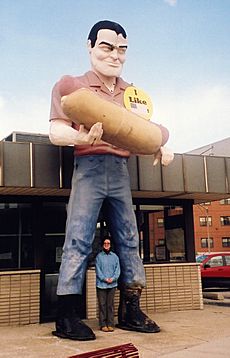Muffler man facts for kids

Muffler Men are giant statues made of fiberglass. You often see them in the United States. They are used to advertise businesses, attract tourists, or just for decoration.
These statues are super tall, usually between 18 and 25 feet! The very first one looked like Paul Bunyan, a giant lumberjack, and he held an axe. Later, other statues were made from the same design. They would hold things like car mufflers, tires, or other items to advertise shops along the road.
Most Muffler Men were built by a company called International Fiberglass in Venice, California. They don't make new ones anymore, but you can still find many of them across the United States and even in Canada. Some famous ones, like Chicken Boy and Gemini Giant, are still standing along the historic U.S. Route 66. These giant statues are so famous they've even appeared in comic strips!
History of the Giant Statues

A boat builder named Steve Dashew started International Fiberglass in 1963. He bought a workshop that already made fiberglass items. Making these huge fiberglass men, women, and dinosaurs started as a side project for his company.
The very first giant figure was made in 1962 by Bob Prewitt. It was a Paul Bunyan statue holding a huge axe. This statue was made to advertise the Paul Bunyan Café on Route 66 in Flagstaff, Arizona.
When Steve Dashew bought the company, he got the molds for this first figure. This meant they could easily make similar characters. They kept the same basic pose, like the right hand up and left hand down, which was how the original Paul Bunyan held his axe.
They could change parts like heads, arms, or bodies using different molds. This allowed them to create many different characters. Some statues would advertise food, while others promoted car products. Examples included a 15-foot Amish man or a Uniroyal gal in a skirt.
Thousands of these huge figures were made in just over ten years. Each one typically cost between $1000 and $2800. Some were custom-made to advertise specific businesses along the US Highway system.
Many were also created for big brands. For example, there were tigers for Enco and Humble Oil, and cowboys for Philips Petroleum. A fiberglass dinosaur was often seen at Sinclair Oil gas stations or miniature golf courses.
When businesses closed or were sold, the statues often got new paint jobs. They would be changed to look like different characters or moved to new places. These statues have become natives, Vikings, football players, and sports mascots. They've also been cooks, cowboys, soldiers, sea pirates, and astronauts!
These unique roadside figures helped small businesses stand out. This was especially important before big highways bypassed the main roads. Businesses on the main road relied on bright neon signage and fun displays to get drivers' attention.
It became harder and more expensive to deliver these large, lightweight figures. Business slowed down, especially after the 1973 oil crisis. International Fiberglass was sold and then closed for good in 1976. The valuable molds for the figures were not saved and are now lost.
Because the company closed, some characters became very rare. For example, the Texaco Big Friend was made for a gas station chain that never launched.
List of Muffler Men


